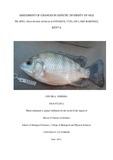| dc.description.abstract | The rapid expansion of tilapia aquaculture farming in the Rift Valley Region of Kenya, has
led to the transfer of different Oreochromis species from farms (ponds) to natural ecosystems
such as rivers and lakes. These transfers have negatively impacted on native tilapia species of
these systems through competition, hybridization and introgression which consequently has
led to the dwindling in number as well as compromising the genetic integrity of the native
species. In Lake Baringo, introductions of tilapia from unverified sources and unknown
species has been reported in the past but has continued due to the rapid expansion of tilapia
farming. The present study aimed at evaluating the current genetic diversity of Oreochromis
species in Lake Baringo in order to determine the recent species introductions and effects on
endemic populations of the Nile tilapia Oreochromis niloticus baringoensis. Morphological
(morphometric and meristics) and molecular techniques involving mtDNA markers
(Cytochrome Oxidase 1, Control region and D-loop genes) were used to identify tilapia
species from the lake. The observed morphometric and meristic differences showed
variations congruent with two tilapia species Oreochromis niloticus and Oreochromis
spirulus. Genetic studies revealed four haplotypes based on maximum likelihood
phylogenetic trees on mtDNA Cytochrome Oxidase 1 and seven haplotypes each for mtDNA
Control region and D-loop marker genes. Blasting, alignment and phylogenetic analysis of
mtDNA D-loop partial fish sample sequences with the NCBI data base sequences for most
cultured tilapia species enabled the identification of the haplotypes as O. n. baringoensis, O.
spilurus, O. n. vulcani, O. niloticus (unknown) and the hybrids of O. n. baringoensis with O.
leucostictus. These findings confirm indications that increased aquaculture activities around
Lake Baringo basin have led to continued species introduction and hybridization in the main
lake, thus endangering the native species O.n baringoensis which form an important role in
commercial fisheries for the communities around the lake. | en_US |

